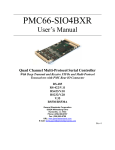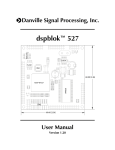Download XEM3010 User`s Manual
Transcript
Opal Kelly XEM3010 User’s Manual A compact (75mm x 50mm) integration board featuring the Xilinx Spartan-3 FPGA and on-board SDRAM. The XEM3010 is a compact USB-based FPGA integration board featuring the Xilinx Spartan-3 FPGA, 32 MB 16-bit wide SDRAM, high-efficiency switching power supply, Xilinx configuration PROM, and two high-density 0.8-mm expansion connectors. The USB 2.0 interface provides fast configuration downloads and FPGA-PC communication as well as easy access with our popular FrontPanel software and developer’s API. An on-board clock generation device has three independent PLLs and five flexible outputs available to the FPGA, SDRAM, and expansion connectors. Software, documentation, samples, and related materials are Copyright © 2006-2009 Opal Kelly Incorporated. Opal Kelly Incorporated Portland, Oregon http://www.opalkelly.com All rights reserved. Unauthorized duplication, in whole or part, of this document by any means except for brief excerpts in published reviews is prohibited without the express written permission of Opal Kelly Incorporated. Opal Kelly, the Opal Kelly Logo, and FrontPanel are trademarks of Opal Kelly Incorporated. Linux is a registered trademark of Linus Torvalds. Microsoft and Windows are both registered trademarks of Microsoft Corporation. All other trademarks referenced herein are the property of their respective owners and no trademark rights to the same are claimed. Revision History: Date Description 20051001 Initial release. 20060215 Added reference to Xilinx Answer Record #18095. 20060223 SDRAM clock connection explained. 20060511 Added SDRAM part number. 20060802 Fixed VCCO2/VCCO3 connections table. Added SDRAM to FPGA pin connections. 20070221 Added note about BRK3010 connections. 20070226 Updated host interface pin list. 20070519 Added note regarding heat dissipation. 20070604 Added note about R43 on PCB revision 20070117. 20070613 Removed overline from SDRAM pin names CKE, LDQM, UDQM. 20070919 Made mandatory deassertion of MUXSEL clearer. 20071127 Fixed typo. Pushbuttons are pulled high to 2.5v. Contents Introducing the XEM3010 . . . . . . . . . . . . . . . . . . . . . . . 5 PCB Footprint. . . . . . . . . . . . . . . . . . . . . . . . . . . . . . . . . . . . . 5 BRK3010 Breakout Board . . . . . . . . . . . . . . . . . . . . . . . . 5 Functional Block Diagram. . . . . . . . . . . . . . . . . . . . . . . . . . . . 6 Power Supply. . . . . . . . . . . . . . . . . . . . . . . . . . . . . . . . . . . . . 6 DC Power Connector. . . . . . . . . . . . . . . . . . . . . . . . . . . . 6 Expansion Bus Power . . . . . . . . . . . . . . . . . . . . . . . . . . . 7 USB Bus Power. . . . . . . . . . . . . . . . . . . . . . . . . . . . . . . . 7 Supply Heat Dissipation (IMPORTANT!!). . . . . . . . . . . . . 7 USB 2.0 Interface. . . . . . . . . . . . . . . . . . . . . . . . . . . . . . . . . . 7 On-board Peripherals. . . . . . . . . . . . . . . . . . . . . . . . . . . . . . . 8 Serial EEPROM. . . . . . . . . . . . . . . . . . . . . . . . . . . . . . . . 8 Cypress CY22393 PLL. . . . . . . . . . . . . . . . . . . . . . . . . . . 8 Xilinx Configuration PROM. . . . . . . . . . . . . . . . . . . . . . . . 8 32-MByte Word-Wide Synchronous DRAM. . . . . . . . . . . 8 LEDs and Pushbuttons. . . . . . . . . . . . . . . . . . . . . . . . . . . 8 Expansion Connectors. . . . . . . . . . . . . . . . . . . . . . . . . . . . . . 8 FrontPanel Support. . . . . . . . . . . . . . . . . . . . . . . . . . . . . . . . . 9 Programmer’s Interface. . . . . . . . . . . . . . . . . . . . . . . . . . 9 Applying the XEM3010 . . . . . . . . . . . . . . . . . . . . . . . . . 11 Host Interface. . . . . . . . . . . . . . . . . . . . . . . . . . . . . . . . . . . . . 11 MUXSEL. . . . . . . . . . . . . . . . . . . . . . . . . . . . . . . . . . . . . . 12 I2C Connections. . . . . . . . . . . . . . . . . . . . . . . . . . . . . . . . 12 LEDs and Pushbuttons. . . . . . . . . . . . . . . . . . . . . . . . . . . . . . 13 Reconfiguration Using S1. . . . . . . . . . . . . . . . . . . . . . . . . 13 PLL Connections . . . . . . . . . . . . . . . . . . . . . . . . . . . . . . . . . . 13 SDRAM Clock . . . . . . . . . . . . . . . . . . . . . . . . . . . . . . . . . 13 JTAG. . . . . . . . . . . . . . . . . . . . . . . . . . . . . . . . . . . . . . . . . . . . 14 JP1 - JTAG Connector. . . . . . . . . . . . . . . . . . . . . . . . . . . 14 JTAG Connection Chain. . . . . . . . . . . . . . . . . . . . . . . . . . 14 SDRAM Connections. . . . . . . . . . . . . . . . . . . . . . . . . . . . . . . 14 Clock Configuration. . . . . . . . . . . . . . . . . . . . . . . . . . . . . 15 Expansion Connectors. . . . . . . . . . . . . . . . . . . . . . . . . . . . . . 16 JP2. . . . . . . . . . . . . . . . . . . . . . . . . . . . . . . . . . . . . . . . . . 16 JP3. . . . . . . . . . . . . . . . . . . . . . . . . . . . . . . . . . . . . . . . . . 16 Setting I/O Voltages. . . . . . . . . . . . . . . . . . . . . . . . . . . . . 16 Power-On I/O State (PCB revision 20070117). . . . . . . . . 17 Considerations for Differential Signals. . . . . . . . . . . . . . . 17 BRK3010 Breakout Board. . . . . . . . . . . . . . . . . . . . . . . . . . . . 18 Xilinx Configuration PROM. . . . . . . . . . . . . . . . . . . . . . . . . . . 19 Generate an FPGA Programming File. . . . . . . . . . . . . . . 19 Generate a PROM Programming File . . . . . . . . . . . . . . . 19 Programming the Configuration PROM. . . . . . . . . . . . . . 21 Booting from PROM. . . . . . . . . . . . . . . . . . . . . . . . . . . . . 22 XEM3010 Mechanical Drawing. . . . . . . . . . . . . . . . . . . 24 XEM3010 User’s Manual BRK3010 Mechanical Drawing . . . . . . . . . . . . . . . . . . . 25 XEM3010 Quick Reference. . . . . . . . . . . . . . . . . . . . . . 26 XEM3010 Quick Reference. . . . . . . . . . . . . . . . . . . . . . 27 4 www.opalkelly.com XEM3010 User’s Manual Introducing the XEM3010 The XEM3010 is a compact (75mm x 50mm, 2.95” x 1.97”) FPGA board featuring the Xilinx Spartan-3 FPGA. Designed as a full-featured integration system, the XEM3010 provides access to over 110 I/O pins on its 320-pin Spartan-3 device and has a 32-MByte SDRAM available to the FPGA. The XEM3010 is designed to work with small to medium-sized FPGA designs with a wide variety of external interface requirements. PCB Footprint A mechanical drawing of the XEM3010 is shown at the end of this manual. The PCB is 75mm x 50mm with four mounting holes spaced as shown in the figure. These mounting holes are electrically isolated from all signals on the XEM3010. The two connectors (USB and DC power) overhang the PCB by approximately 4mm in order to accomodate mounting within an enclosure. The XEM3010 has two high-density 80-pin connectors on the bottom side which provide access to many FPGA pins, power, JTAG, and the microcontroller’s I2C interface. BRK3010 Breakout Board A simple breakout board (the BRK3010) is provided as an optional accessory to the XEM3010. This breakout board provides easy access to the high-density connectors on the XEM3010 by routing them to lower-density 0.1”-spaced thru-holes. The breakout board also provides a convenient reference for building boards that will mate to the XEM3010. A mechanical drawing of the BRK3010 is also shown at the end of this document. www.opalkelly.com 5 XEM3010 User’s Manual Functional Block Diagram PROM (XCF08P) USB SDRAM (MT48LC16M16) USB Micro (CY68013A) Host Interface Bus PLL (CY22393) 3 PLL CLKs Spartan-3 FPGA (XC3S1000-4FG320 or XC3S1500-4FG320) 58 I/O 2 GCLK 1 PLL CLK 58 I/O 2 GCLK 10 I/O 2 Pushbuttons 8 LEDs XBUS (JP2) 1 PLL CLK YBUS (JP3) Power Supply The XEM3010 is designed to be operated from one of three power sources, depending on user requirements. One of these three sources provides power for the two high-efficiency switching regulators on-board to provide 3.3v and 1.2v. 2.5v and 1.8v are derived from the 3.3v supply using small low-dropout (LDO) regulators. The three sources and the respective XEM3010 configuration for each are shown in the table below. In all configurations, the XEM3010 requires a clean, well-regulated supply between 4.5v and 5.5v. Power Source XEM3010 Configuration DC Power Jack (P1) No configuration is required. Attach a DC power source to P1 that supplies a clean, regulated voltage of 4.5v to 5.5v. Expansion Connector (JP3) No configuration is required. Provide a clean, regulated voltage of 4.5v to 5.5v to the VDC pins on JP3. USB Bus Power See section on “USB Bus Power” IMPORTANT NOTE: Only one power source should be connected at any time. Attaching multiple power sources could damage the XEM3010 and possibly the power source, and void the warranty on the XEM3010. There two switching regulators on-board, one for the 3.3v supply and one for the 1.2v supply. Each supply has been designed to provide up to 3 A of continuous current. It is unlikely that the XEM3010 will consume this much current, so much of this power will be available to expansion devices using the expansion connectors. DC Power Connector The DC power connector on the XEM3010 is part number PJ-102A from CUI, Inc. It has a standard 2.1mm /5.5mm power jack. The outer ring is attached to DGND. The center pin is attached 6 www.opalkelly.com XEM3010 User’s Manual to +VDC on expansion connector JP3 as well as the inputs to the two switching regulators on the XEM3010. Expansion Bus Power The expansion bus has pins for +VDC, +3.3V, and +1.2V, making it flexible for nearly any supply scenario. In particular, the following scenarios have been considered: • • • • +VDC is provided to an expansion device which use or regulate it as necessary. +VDC is provided by an expansion device to power the XEM3010. +3.3V and/or +1.2V are provided to expansion devices as regulated, reliable supplies. +3.3V and/or +1.2V are provided by an expansion device to power the XEM3010. In this case, the switching regulators on the board must be removed. This option may be useful to applications where a switching supply is not desired. USB Bus Power The USB 2.0 specification allows for up to 2.5 W (500mA at 5v) to be provided to external peripherals over the USB cable. While power consumption of an unconfigured XEM3010 is quite low, due to the flexibility allowed in FPGA design, the Spartan-3 and SDRAM could easily consume over 2.5 W during operation with a user design, thus violating the USB specification. However, to support users who may not be consuming that much power in their design and who may still wish to use the XEM3010 in a bus-powered situation, we have provided a solder jumper (J3) on the bottom of the XEM3010. WIth a bead of solder in place across this jumper, the USB +5V is connected to +VDC. Before relying on USB power, you should be aware of the limitations and the fact that using USB power may render the XEM3010 a USB-noncompliant device. Supply Heat Dissipation (IMPORTANT!!) Due to the limited area available on the small form-factor of the XEM3010 and the density of logic provided, heat dissipation may be a concern. This depends entirely on the end application and cannot be predicted in advance by Opal Kelly. Heat sinks may be required on any of the devices on the XEM3010. Of primary focus should be the FPGA (U11), the two switching power supplies (U1, U2), and the SDRAM (U14). Although the two switching supplies are high-efficiency, they are very compact and consume a small amount of PCB area for the current they can provide. If you plan to put the XEM3010 in an enclosure, be sure to consider heat dissipation in your design. USB 2.0 Interface The XEM3010 uses a Cypress CY7C68013A FX2LP USB microcontroller to make the XEM a USB 2.0 peripheral. As a USB peripheral, the XEM is instantly recognized as a plug and play peripheral on millions of PCs. More importantly, FPGA downloads to the XEM happen blazingly fast, virtual instruments under FrontPanel update quickly, and data transfers are much faster than the parallel port interfaces common on many FPGA experimentation boards. www.opalkelly.com 7 XEM3010 User’s Manual On-board Peripherals The XEM3010 is designed to compactly support a large number of applications with a small number of on-board peripherals. These peripherals are listed below. Serial EEPROM A small serial EEPROM is attached to the USB microcontroller on the XEM3010, but not directly available to the FPGA. The EEPROM is used to store boot code for the microcontroller as well as PLL configuration data and a device identifier string. The PLL configuration data is loaded from EEPROM and used to reconfigure the PLL each time a new configuration file is loaded to the FPGA. Therefore, stable and active clocks will be present on the FPGA pins as soon as it comes out of configuration. The stored PLL configuration may be changed at any time using FrontPanel’s PLL Configuration Dialog. The EEPROM also stores a device identifier string which may be changed at any time using FrontPanel. The string serves only a cosmetic purpose and is used when multiple XEM devices are attached to the same computer so you may select the proper active device. Cypress CY22393 PLL A multi-output, triple-PLL clock generator can provide up to five clocks, three to the FPGA and another two to the expansion connectors JP2 and JP3. The PLL is driven by a 48-MHz signal output from the USB microcontroller. The PLL can output clocks up to 150-MHz and is configured through the FrontPanel software interface or the FrontPanel API. Xilinx Configuration PROM An 8-Mbit Xilinx PROM (XCF08P) is included on some variants of the XEM3010. This PROM allows the XEM3010 to operate without its USB tether by automatically configuring the on-board FPGA during power-up. This PROM may be programmed over the board’s JTAG port using a Xilinx configuration cable and the iMPACT software. 32-MByte Word-Wide Synchronous DRAM The XEM also includes a 32-MByte SDRAM with a full 16-bit word-wide interface to the FPGA. This SDRAM is attached exclusively to the FPGA and does not share any pins with the expansion connector. The maximum clock rate of the SDRAM is 133 MHz. The SDRAM is a Micron MT48LC16M16A2BG-75:D (or compatible). LEDs and Pushbuttons Eight LEDs and two pushbuttons are available for general use as debug inputs and outputs. Expansion Connectors Two high-density, 80-pin expansion connectors are available on the bottom-side of the XEM3010 PCB. These expansion connectors provide user access to several power rails on the XEM3010, two clock generator outputs, four FPGA clock inputs, the USB microcontroller I2C lines, the JTAG chain, and 116 non-shared I/O pins on the FPGA. The connectors on the XEM3010 are Samtec part number: BSE-040-01-F-D-A. The table below lists the appropriate Samtec mating connectors along with the total mated height. 8 www.opalkelly.com XEM3010 User’s Manual Samtec Part Number Mated Height BTE-040-01-F-D-A 5.00mm (0.197”) BTE-040-02-F-D-A 8.00mm (0.315”) BTE-040-03-F-D-A 11.00mm (0.433”) BTE-040-04-F-D-A 16.10mm (0.634”) BTE-040-05-F-D-A 19.10mm (0.752”) FrontPanel Support The XEM3010 is fully supported by Opal Kelly’s FrontPanel software. FrontPanel augments the limited peripheral support with a host of PC-based virtual instruments such as LEDs, hex displays, pushbuttons, toggle buttons, and so on. Essentially, this makes your PC a reconfigurable I/O board and adds enormous value to the XEM3010 as an experimentation or prototyping system. Programmer’s Interface In addition to complete support within FrontPanel, the XEM3010 is also fully supported by the FrontPanel programmer’s interface (API), a powerful C++ class library available to Windows and Linux programmers allowing you to easily interface your own software to the XEM. In addition to the C++ library, wrappers have been written for Java and Python making the API available under those languages as well. Java and Python extensions are available under Windows and Linux. Sample wrappers are also provided for Matlab and LabVIEW. Complete documentation and several sample programs are installed with FrontPanel. www.opalkelly.com 9 XEM3010 User’s Manual 10 www.opalkelly.com XEM3010 User’s Manual Applying the XEM3010 Host Interface There are 24 pins that connect the on-board USB microcontroller to the FPGA. These pins comprise the host interface on the FPGA and are used for configuration downloads. After configuration, these pins are used to allow FrontPanel communication with the FPGA. If the FrontPanel okHostInterface module is instantiated in your design, you must map the interface pins to specific pin locations using Xilinx LOC constraints. This may be done using the Xilinx constraints editor or specifying the constraints manually in a text file. An example is shown below: Xilinx constraints for okHostInterface pin mappings: www.opalkelly.com 11 XEM3010 User’s Manual NET NET NET NET NET NET NET NET NET NET NET NET NET NET NET NET NET NET NET NET NET NET NET NET NET NET “hi_in<0>” “hi_in<1>” “hi_in<2>” “hi_in<3>” “hi_in<4>” “hi_in<5>” “hi_in<6>” “hi_in<7>” “hi_out<0>” “hi_out<1>” “hi_inout<0>” “hi_inout<1>” “hi_inout<2>” “hi_inout<3>” “hi_inout<4>” “hi_inout<5>” “hi_inout<6>” “hi_inout<7>” “hi_inout<8>” “hi_inout<9>” “hi_inout<10>” “hi_inout<11>” “hi_inout<12>” “hi_inout<13>” “hi_inout<14>” “hi_inout<15>” LOC LOC LOC LOC LOC LOC LOC LOC LOC LOC LOC LOC LOC LOC LOC LOC LOC LOC LOC LOC LOC LOC LOC LOC LOC LOC = = = = = = = = = = = = = = = = = = = = = = = = = = “N10”; “V2”; “V3”; “V12”; “R8”; “T8”; “V8”; “V7”; “V10”; “V11”; “T7”; “R7”; “V9”; “U9”; “P11”; “N11”; “R12”; “T12”; “U6”; “V5”; “U5”; “V4”; “U4”; “T4”; “T5”; “R5”; Each of the samples installed with FrontPanel includes a copy of a template constraints file that lists all the XEM3010 pins and maps them to the appropriate FPGA pins using LOC (location) constraints. You can use this template to quickly get the pin locations correct on a new design. MUXSEL MUXSEL is a signal on the XEM3010 which selects the signal path to the FPGA programming signals D0 and CCLK. When low (deasserted), the FPGA and USB microcontroller are connected. When high (asserted), the FPGA and PROM are connected. In normal USB-programmed operation, J1 is inserted pulling MUXSEL low and connecting the FPGA and USB microcontroller at all times. This allows USB-based programming of the FPGA and subsequent USB communication with the FPGA design after configuration. In order to allow the PROM to configure the FPGA, J1 must be removed. In order to deassert MUXSEL post-configuration, your design must deassert MUXSEL. This allows the FPGA design to properly startup and allows for communication over USB even after the PROM has configured it. The end result is that your FPGA design should tie HI_MUXSEL to 0. This is the case regardless of how the design was configured (via PROM or USB) and even if you have a PROM-less version of the XEM3010. For example, in Verilog: assign hi_muxsel = 1’b0; I2C Connections The FPGA on the XEM3010 is attached to the I2C lines from the USB microcontroller. In order to avoid contention with the I2C bus, these lines should be set to high-impedance within your design. If this is not done, FrontPanel may timeout or hang when trying to communicate with the XEM3010, particularly when programming the on-board PLL. 12 www.opalkelly.com XEM3010 User’s Manual The following lines in your UCF (contraints) file will attach pull-ups to the I2C lines: NET “i2c_scl” NET “i2c_sda” LOC = “U13” | PULLUP; LOC = “R13” | PULLUP; In addition, you will need to set these signals to high-impedance in your HDL. Here is an example of how to do this in Verilog: assign i2c_sda = 1’bz; assign i2c_scl = 1’bz; LEDs and Pushbuttons There are eight LEDs and two pushbuttons on the XEM3010. Each is wired directly to the FPGA according to the pin mapping tables at the end of this document. The LED anodes are connected to a pull-up resistor to +3.3VDD and the cathodes wired directly to the FPGA. To turn ON an LED, the FPGA pin should be brought low. To turn OFF an LED, the FPGA pin should be brought high. The pushbuttons are connected between their respective FPGA pin and DGND. The FPGA side of the connection has a pull-up resistor to +2.5VDD. Therefore, in the pressed state, the FPGA pin will be at DGND (low) and in the unpressed state, the FPGA pin will be at +2.5VDD (high). Note that the pushbuttons are not debounced on the XEM3010. In order to deglitch the signals from the pushbuttons, proper debouncing should be done inside the FPGA. Reconfiguration Using S1 When a jumper is installed across J2, S1 is electrically connected to the PROG_B pin on the FPGA. In this configuration, S1 may be used to force the FPGA to reprogram itself using the image in PROM. Note that this mode is only available when the XEM3010 is configured for PROM configuration of the FPGA. When the XEM3010 is configured for USB configuration, no jumper should be installed across J2. PLL Connections The PLL contains six output pins, one of which is left unconnected. The other five are labelled SYS_CLK1 through SYS_CLK5. SYS_CLK4 connects to JP2 and SYS_CLK5 connects to JP3. The other three pins are connected directly to the FPGA. The pin mapping table at the end of this document details the PLL connections. SDRAM Clock The SDRAM clock pin (U14-F2) is connected to SYS_CLK1 which is CLKA on the Cypress CY22393 PLL (U8-10). Note that this connection is shared with FPGA GCLK3 (U11-N9). www.opalkelly.com 13 XEM3010 User’s Manual JTAG JP1 - JTAG Connector JP1 is the 2mm, 6-pin JTAG connector on-board and connects to the on-board JTAG chain which includes the FPGA, configuration PROM, and expansion connector. These pins can be connected to an external JTAG command converter (such as the Xilinx JTAG cables) for additional programming capability. The JP1 pins are connected as shown below: JP1 Pin Signal 1 +2.5VDD 2 TMS 3 TCK 4 TDI 5 DGND 6 TDO JTAG Connection Chain The JTAG chain is configured as shown in the diagram below. The PROM and expansion port of this chain may be bypassed using optional 0-Ω resistors, as shown. R16 bypasses the PROM and has been inserted on PROM-less versions of the XEM3010. R16 is not inserted on XEM3010 versions with the PROM. R30 bypasses the expansion connector and has been inserted on all versions of the XEM3010. If your application places additional components in the JTAG chain, you must remove R30. Note that the JTAG signal level on the XEM3010 is 2.5-v. If your expansion board extends this chain, it must also operate at 2.5-v or use level translation to be compatible. TDO TDO (JP2-8) XBUS (JP2) TDI (JP2-9) JTAG (JP1) TDO FPGA TDI (JP1-4) TDI TDO R30 PROM (XCF08P) TDI R16 SDRAM Connections The Micron SDRAM is connected exclusively to the 3.3v I/O on Bank 0 and Bank 1 of the FPGA. The tables below list these connections. 14 www.opalkelly.com XEM3010 User’s Manual SDRAM Pin FPGA Pin SDRAM Pin FPGA Pin CLK N9 A10 A17 CKE F8 A11 B10 CS E8 A12 A10 WE E7 D0 C4 CAS E11 D1 D5 RAS D12 D2 C5 BA0 C12 D3 D6 BA1 A14 D4 D7 LDQM D9 D5 C7 UDQM A9 D6 C8 A0 A15 D7 D8 A1 A16 D8 B9 A2 B15 D9 A8 A3 B14 D10 A7 A4 D11 D11 B6 A5 B13 D12 A5 A6 C11 D13 B5 A7 A12 D14 A4 A8 A11 D15 B4 A9 D10 Clock Configuration The XEM3010 has been designed to support SDRAM clocking in both “system synchronous” and “source synchronous” modes. Both configurations are often referenced in Xilinx application notes describing SDRAM controllers and interfaces. System Synchronous In this mode, the clock signal is sourced at the system level by the PLL on the XEM3010. The same clock is fanned-out to both the FPGA (pin N9) and the SDRAM (CLK). The FPGA, therefore considers this signal an input and synchronizes its logic fabric to it, typically using a DCM. Source Synchronous In this mode, the clock signal is sourced by the FPGA rather than the PLL. To avoid signal contention, the corresponding output (SYS_CLK1) on the PLL must be disabled or increased power consumption and potential damage may be done. The FPGA pin N9 is configured as an output and provides the clock signal to the SDRAM. Typically, this setup uses the DDR features of the IOB to provide a clock that is well-synchronized with the signals output to and input from the SDRAM, thus minimizing signal skew with respect to the clock. www.opalkelly.com 15 XEM3010 User’s Manual Expansion Connectors JP2 JP2 is an 80-pin high-density connector providing access to FPGA Banks 2 and 3. Pins 77 and 79 of this connector are wired to global clock inputs on the FPGA and can therefore be used as inputs to the global clock network. Pin 11 on this connector is SYSCLK4 and is directly connected to CLKD on the Cypress CY22393 PLL. Using FrontPanel’s PLL Configuration Dialog, you can configure the clock signal present on this pin. Pin mappings for JP2 are listed at the end of this document in the “Quick Reference” section. For each JP2 pin, the corresponding board connection is listed. For pins connected to the FPGA, the corresponding FPGA pin number is also shown. Finally, for pins routed to differential pair I/ Os on the FPGA, the FPGA signal names and routed track lengths have been provided to help you equalize lengths on differential pairs. JP3 JP3 is an 80-pin high-density connector providing access to FPGA Banks 6 and 7. Pins 77 and 79 of this connector are wired to global clock inputs on the FPGA and can therefore be used as inputs to the global clock network. Pin 8 on this connector is SYSCLK5 and is directly connected to CLKE on the Cypress CY22393 PLL. Using FrontPanel’s PLL Configuration Dialog, you can configure the clock signal present on this pin. Pin mappings for JP3 are listed at the end of this document in the “Quick Reference” section. For each JP3 pin, the corresponding board connection is listed. For pins connected to the FPGA, the corresponding FPGA pin number is also shown. Finally, for pins routed to differential pair I/Os on the FPGA, the FPGA signal names and routed track lengths have been provided to help you equalize lengths on differential pairs. Setting I/O Voltages The Spartan-3 FPGA allows users to set I/O bank voltages in order to support several different I/O signalling standards. This functionality is supported by the XEM3010 by allowing the user to connect independent supplies to the FPGA VCCO pins on four of the FPGA banks. By default, ferrite beads have been installed which attach each VCCO bank to the +3.3VDD supply. If you intend to supply power to a particular I/O bank, you MUST remove the appropriate ferrite beads. Power can then be supplied through the expansion connectors. The table below lists details for user-supplied I/O bank voltages 16 I/O Bank Expansion Pin FPGA Pins Ferrite Bead 2 JP2-55 J12, H12, F16 FB2 3 JP2-35 N16, L12, K12 FB3 6 JP3-36 K7, L7, N3 FB4 7 JP3-56 F3, H7, J7 FB5 www.opalkelly.com XEM3010 User’s Manual Clock Inputs and Bank Voltages Note that the four clock inputs available on the expansion connectors are connected to FPGA banks 0 and 1. Bank voltages for these two banks are fixed on the XEM3010 to +3.3VDD. However, Xilinx Answer Record #18095 states: Differential Input Buffers are powered by VCCAUX and are not VCCO-dependent. Consequently, you can put LVDS_25 and LVPECL_25 input buffers in a 3.3V bank without damaging the device. Instantiating a LVDS_25 or LVPECL_25 input buffer in 3.3V bank does not generate a software error. For more information on this, please refer to the Xilinx Answer Record and other references available within that record. Power-On I/O State (PCB revision 20070117) In all versions of the XEM3010 PCB prior to 20070117 (YYYYMMDD datecode), the HSWAP_EN pin (E6 on the FPGA) was directly connected to DGND. This enables pull-up resistors on all User I/Os from power-on throughout configuration. (See the Spartan-3 Data Sheet from Xilinx). With version 20070117, a 0-Ω resistor has been added (R43). By default, this resistor IS NOT LOADED. This resistor connects HSWAP_EN to DGND. Therefore, for version 20070117 there are two possible configurations: Remove R43 (Default Configuration) HSWAP_EN is allowed to float and an internal pull-up pulls HSWAP_EN high. This disables the user I/O pull-up resistors allowing the I/Os to float from power-on throughout configuration. Insert R43 (0-Ω Resistor) HSWAP_EN is grounded. This enables user I/O pull-up resistors from power-on throughout configuration. See the Xilinx Spartan-3 Data Sheet for details regarding the characteristics of these pull-ups. Considerations for Differential Signals The XEM3010 PCB layout and routing has been designed with several applications in mind, including applications requiring the use of differential (LVDS) pairs. Please refer to the Xilinx Spartan-3 datasheet for details on using differential I/O standards with the Spartan-3 FPGA. FPGA I/O Bank Voltages In order to use differential I/O standards with the Spartan-3, you must set the VCCO voltages for the appropriate banks to 2.5v according to the Xilinx Spartan-3 datasheet. Please see the section above entitled “Setting I/O Voltages” for details. Characteristic Impedance The characteristic impedance of all routes from the FPGA to the expansion connector is 50-Ω, with the exception of routes that are labelled with (†) in the mapping table. These exception routes are routed on inner layers without a proximity ground plane and therefore do not match the 50-Ω impedance exactly. www.opalkelly.com 17 XEM3010 User’s Manual Differential Pair Lengths In many cases, it is desirable that the route lengths of a differential pair be matched within some specification. Care has been taken to route differential pairs on the FPGA to adjacent pins on the expansion connectors whenever possible. We have also included the lengths of the board routes for these connections to help you equalize lengths in your final application. Due to space constraints, some pairs are better matched than others. Digitally Controlled Impedance (DCI) The Xilinx Spartan-3 supports digitally controlled impedance. This functionality is supported when precision resistors are connected externally between the FPGA VRN/VRP lines and +VCCO/DGND, respectively. Pads for these resistors have been placed and routed on the XEM3010, but resistors have NOT been installed. The end-user must install these resistors in order to use DCI. The table below lists the resistor designators and the banks they control. Resistor FPGA Pin FPGA Signal Connection R22 C17 L01P_2/VRN_2 +VCCO2 R24 C16 L01N_2/VRP_2 DGND R21 T16 L01P_3/VRN_3 +VCCO3 R23 T17 L01N_3/VRP_3 DGND R18 T2 L01P_6/VRN_6 +VCCO6 R20 T3 L01N_6/VRP_6 DGND R17 C2 L01P_7/VRN_7 +VCCO7 R19 C3 L01N_7/VRP_7 DGND BRK3010 Breakout Board The BRK3010 is a simple two-layer “breakout board” which can be used to evaluate or transition to the XEM3010. It provides standard 0.1” thru-hole connections to the 0.8-mm high-density connectors on the XEM3010. The corresponding connections to the XEM3010 are labelled in silkscreen on the BRK3010. The BRK3010 connectors essentially mirror the connections on the XEM3010, left to right. For example, the JP2 connector on the XEM3010 is electrically connected to JP1/JP2 on the BRK3010 according to the table below. A similar mapping exists for JP3 on the XEM3010. 18 BRK3010 XEM3010 JP1-1 JP2-2 JP1-2 JP2-1 JP1-3 JP2-4 JP1-4 JP2-3 ... ... JP2-38 JP2-77 JP2-39 JP2-80 JP2-40 JP2-79 www.opalkelly.com XEM3010 User’s Manual Xilinx Configuration PROM Some versions of the XEM3010 are built with a Xilinx configuration PROM inserted. This PROM allows the FPGA to be configured upon power-up without a USB connection as some applications may require the FPGA to control a user’s device and only occasionally be connected to a PC. The USB connection may therefore be used for extracting acquired data, adjusting parameters, and so on. Getting the XEM3010 to boot from a PROM-based FPGA configuration is a multistep process consisting of the following steps: 1. Generate an FPGA programming file. 2. Generate a PROM programming file from the FPGA programming file. 3. Program the PROM. Generate an FPGA Programming File. This step is performed for either PROM-boot or USB-boot and is the final step in a typical FPGA synthesis flow. It is assumed that the user is already familiar with this procedure and it will not be covered here. Generate a PROM Programming File In this step, the Xilinx iMPACT tool is used to format a PROM programming file with the FPGA programming file created previously. In the next step, the PROM programming file will be transferred (e.g. via JTAG) to the PROM. Start iMPACT Once the FPGA programming file (bitfile) has been created, you can start iMPACT from within Project Navigator by clicking on “Generate PROM, ACE, or JTAG File” in the processes list. This will start iMPACT. When asked, tell it you would like to create a PROM File. Setup PROM File Format At the next screen, select “Xilinx PROM” as a target with the “MCS” format. Here you can also specify a filename for your programming file. www.opalkelly.com 19 XEM3010 User’s Manual Select the PROM Device At the next screen, check “Enable Revisioning”. This is necessary in order to enable some features of the Xilinx PROM that allow it to boot the FPGA as a programming master. Select the PROM device as “xcf08p,” the device on the XEM3010, and add it to the list. 20 www.opalkelly.com XEM3010 User’s Manual Add Bitfiles to PROM The final step in creating the PROM is to add your bitfile to the PROM. Simply select the file (e.g. counters.bit) that you generated previously. Once you complete the Wizard, the MCS programming file will be created in the directory specified. In our case, we have CountersPROM.mcs. Programming the Configuration PROM Once we have a PROM programming file, we can transfer that file to the Xilinx Configuration PROM on the XEM3010 using a JTAG cable. The Xilinx Parallel IV or Xilinx USB JTAG cables will work just fine for this process. Connecting to the JTAG Chain At this point, you may attach your programming cable to the XEM3010. Be sure to connect the pins correctly or you could damage the XEM3010 or the programming cable. If you are still in iMPACT, you can switch to Configuration Mode using the “Mode” menu at the top of the window. Allow iMPACT to automatically discover the JTAG chain and you will end up with a graphical representation of the chain. Assign the PROM Configuration File Assign the PROM configuration file (CountersPROM.mcs) that you created in the previous step to the XCF08P device. You may bypass the XC3S1500 device since we will only be configuring the PROM. Program the PROM Once a configuration file has been assigned to the PROM device, you will be able to program it by right-clicking on the device and selecting “Program...” from the context menu. In the options dialog, setup the following options: • • • • • Select Rev 0 and “ER” to erase any existing configuration PROM is Configuration Master Internal Clock Clock Frequency set to 40 MHz I/O Configuration is Serial Mode www.opalkelly.com 21 XEM3010 User’s Manual Once you acknowledge this dialog, the programming operation will start. Once complete, the PROM should be setup with your new FPGA programming file! Booting from PROM In order to boot the XEM3010 from PROM, you must remove the jumper on J1. This allows the PROM to configure the FPGA from power-on. If your FPGA design has MUXSEL=0, the design will still be able to communicate with FrontPanel if it is connected to a PC. 22 www.opalkelly.com XEM3010 User’s Manual www.opalkelly.com 23 XEM3010 User’s Manual XEM3010 Mechanical Drawing 24 www.opalkelly.com XEM3010 User’s Manual 96 100 84.31 66.91 72.04 26.92 28 32.03 13.19 0 4 BRK3010 Mechanical Drawing 0 3 4 2.50 24.80 32.27 33.90 0.90 2.80 71.12 0.10 2.54 88.30 0.60 15.24 66.73 72 0.10 2.54 146 150 All dimensions in mm. [inches] www.opalkelly.com 25 XEM3010 User’s Manual XEM3010 Quick Reference JP2 Pin Connection FPGA Pin Host Interface Pin FPGA Pin 1 DGND 2 3 +2.5VDD 4 +3.3VDD HI_IN[0] N10 +3.3VDD HI_IN[1] 5 JTAG_TCK 6 V2 +3.3VDD HI_IN[2] 7 JTAG_TMS V3 8 X_TDO HI_IN[3] 9 V12 X_TDI 10 - HI_IN[4] R8 11 SYS_CLK4 12 - HI_IN[5] T8 13 DGND 14 DGND HI_IN[6] V8 15 XBUS-1 T16 (*) L01P_3 17.196 16 XBUS-0 U18 L16P_3 17.089 HI_IN[7] V7 17 XBUS-3 T17 (*) L01N_3 12.588 18 XBUS-2 T18 L16N_3 17.172 HI_OUT[0] V10 19 XBUS-5 R16 L17P_3 13.817 20 XBUS-4 R17 L19N_3 18.255 HI_OUT[1] V11 21 XBUS-7 P15 L21N_3 14.607 22 XBUS-6 R18 L19P_3 16.923 HI_INOUT[0] T7 23 XBUS-9 P16 L17N_3 13.276 24 XBUS-8 P17 L20P_3 18.006 HI_INOUT[1] R7 25 XBUS-11 N15 L21P_3 14.359 26 XBUS-10 P18 L20N_3 16.675 HI_INOUT[2] V9 27 XBUS-13 M15 L23N_3 14.442 28 XBUS-12 N17 L24P_3 17.757 HI_INOUT[3] U9 29 XBUS-15 M16 L23P_3 13.110 30 XBUS-14 M18 L24N_3 17.426 HI_INOUT[4] P11 31 XBUS-17 L15 L34N_3 16.068 32 XBUS-16 L17 L35P_3 18.450 HI_INOUT[5] N11 33 XBUS-19 L16 L34P_3 14.736 34 XBUS-18 L18 L35N_3 16.885 HI_INOUT[6] R12 35 +VCCO3 36 DGND HI_INOUT[7] T12 37 XBUS-21 N14 (†) L22P_3 13.950 38 XBUS-20 K17 L40N_3 17.509 HI_INOUT[8] U6 39 XBUS-23 M14 (†) L22N_3 14.282 40 XBUS-22 K18 L40P_3 16.509 HI_INOUT[9] V5 41 XBUS-25 K13 (†) L39N_3 14.951 42 XBUS-24 L14 (†) L27N_3 19.266 HI_INOUT[10] U5 43 XBUS-27 K14 (†) L39P_3 13.619 44 XBUS-26 L13 (†) L27P_3 19.935 HI_INOUT[11] V4 45 XBUS-29 K15 - 12.288 46 XBUS-28 J13 (†) - 21.426 HI_INOUT[12] U4 47 XBUS-31 J14 (†) L40P_2 14.316 48 XBUS-30 H13 (†) L27N_2 22.119 HI_INOUT[13] T4 49 XBUS-33 J15 L40N_2 12.868 50 XBUS-32 H14 (†) L27P_2 20.539 HI_INOUT[14] T5 51 XBUS-35 G14 (†) L22P_2 16.068 52 XBUS-34 J18 L39N_2 15.680 HI_INOUT[15] R5 53 XBUS-37 F14 (†) L22N_2 15.736 54 XBUS-36 J17 L39P_2 16.929 55 +VCCO2 56 DGND 57 XBUS-39 H16 L34N_2 10.791 58 XBUS-38 H18 L35P_2 15.515 59 XBUS-41 H15 L34P_2 12.163 60 XBUS-40 H17 L35N_2 16.680 61 XBUS-43 G16 L24P_2 11.205 62 XBUS-42 G18 L23N_2 15.515 63 XBUS-45 G15 L24N_2 12.205 64 XBUS-44 F17 L23P_2 15.686 65 XBUS-47 F15 L21N_2 12.039 66 XBUS-46 E18 L20P_2 14.355 67 XBUS-49 E16 L19P_2 10.956 68 XBUS-48 E17 L20N_2 15.686 69 XBUS-51 E15 L21P_2 12.288 70 XBUS-50 D18 L17P_2 15.018 71 XBUS-53 D16 L19N_2 11.205 72 XBUS-52 D17 L17N_2 16.101 73 XBUS-55 C17 (*) L01P_2 10.785 74 XBUS-54 C18 L16P_2 14.852 75 XBUS-57 C16 (*) L01N_2 11.453 76 XBUS-56 B18 L16N_2 16.601 77 XCLK1 F10 L32P_1 21.992 78 DGND 79 XCLK2 E10 L32N_1 21.756 80 DGND LVDS Length (mm) JP2 Pin Connection FPGA Pin Notes: * - Pin is a DCI pin with optionally-installed resistors. † - Some routing on inner layer is not necessarily 50Ω. 26 www.opalkelly.com Length (mm) LVDS LED FPGA Pin D2 V14 D3 U14 D4 T14 D5 V15 D6 U15 D7 V16 D8 V17 D9 U16 Button FPGA Pin S1 P7 S2 P6 PLL Pin Clock Name Connection CLKA SYS_CLK1 FPGA - N9 CLKB SYS_CLK2 FPGA - P9 CLKC SYS_CLK3 FPGA - P10 CLKD SYS_CLK4 JP2-11 CLKE SYS_CLK5 JP3-8 XBUF N/A Not Connected XEM3010 User’s Manual XEM3010 Quick Reference JP3 Pin Connection 1 3 FPGA Pin JP3 Pin Connection FPGA Pin LVDS Length (mm) +VDC 2 DGND +VDC 4 +1.2VDD 5 +VDC 6 +1.2VDD 7 - 8 SYS_CLK5 9 +3.3VDD 10 USB_SCL 11 +3.3VDD 12 USB_SDA 13 +3.3VDD 14 DGND 15 YBUS-1 U1 L16N_6 17.689 16 17 YBUS-3 T1 L16P_6 17.772 18 YBUS-0 T3 (*) L01N_6 15.573 YBUS-2 T2 (*) L01P_6 19 YBUS-5 R2 L17N_6 18.855 17.182 20 YBUS-4 R3 L19N_6 21 YBUS-7 R1 L17P_6 14.125 17.523 22 YBUS-6 P4 L21P_6 23 YBUS-9 P2 15.207 L20N_6 18.606 24 YBUS-8 P3 L19P_6 25 YBUS-11 13.876 P1 L20P_6 17.275 26 YBUS-10 N4 L21N_6 27 14.959 YBUS-13 N2 L24N_6 18.357 28 YBUS-12 M4 L23P_6 15.042 29 YBUS-15 M1 L24P_6 17.967 30 YBUS-14 M3 L23N_6 13.876 31 YBUS-17 L2 L35N_6 19.050 32 YBUS-16 L4 L34P_6 15.320 33 YBUS-19 L1 L35P_6 17.719 34 YBUS-18 L3 L34N_6 14.155 35 DGND 36 +VCCO6 37 YBUS-21 K2 L40P_6 18.470 38 YBUS-20 N5 (†) L22N_6 14.302 39 YBUS-23 K1 L40N_6 17.139 40 YBUS-22 M5 (†) L22P_6 14.053 41 YBUS-25 K5 (†) L39N_6 20.280 42 YBUS-24 L5 (†) L27P_6 14.136 43 YBUS-27 K4 (†) L39P_6 19.612 44 YBUS-26 L6 (†) L27N_6 14.805 45 YBUS-29 J6 (†) 22.436 46 YBUS-28 K6 - 16.423 47 YBUS-31 J5 (†) L40N_7 20.529 48 YBUS-30 H6 (†) L27P_7 16.213 49 YBUS-33 J4 (†) L40P_7 19.198 50 YBUS-32 H5 (†) L27N_7 14.882 51 YBUS-35 J1 L39N_7 17.602 52 YBUS-34 G5 (†) L22N_7 15.185 53 YBUS-37 J2 L39P_7 18.485 54 YBUS-36 F5 (†) L22P_7 15.048 55 DGND 56 +VCCO7 57 YBUS-39 H1 L35N_7 16.446 58 YBUS-38 H3 L34P_7 11.971 59 YBUS-41 H2 L35P_7 17.446 60 YBUS-40 H4 L34N_7 12.971 61 YBUS-43 G1 L23N_7 16.032 62 YBUS-42 G3 L24P_7 11.556 63 YBUS-45 F2 L23P_7 16.618 64 YBUS-44 G4 L24N_7 12.722 65 YBUS-47 E1 L20P_7 16.612 66 YBUS-46 F4 L21P_7 12.971 67 YBUS-49 E2 L20N_7 17.612 68 YBUS-48 E3 L19N_7 11.556 69 YBUS-51 D1 L17N_7 16.198 70 YBUS-50 E4 L21N_7 13.219 71 YBUS-53 D2 L17P_7 17.198 72 YBUS-52 D3 L19P_7 11.805 73 YBUS-55 C1 L16N_7 15.784 74 YBUS-54 C2 (*) L01P_7 16.590 75 YBUS-57 B1 L16P_7 15.369 76 YBUS-56 C3 (*) L01N_7 16.200 77 YCLK1 E9 L32N_0 29.060 78 DGND 79 YCLK2 F9 L32P_0 30.743 80 DGND LVDS Length (mm) Notes: * - Pin is a DCI pin with optionally-installed resistors. † - Some routing on inner layer is not necessarily 50Ω. www.opalkelly.com 27
















































